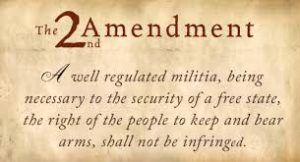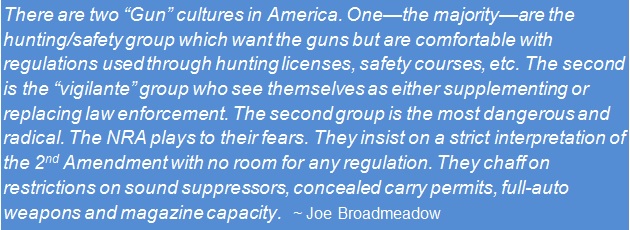 Every socially interconnected person in the world watches news reports of mass shootings in the United States of America. Most horrific are school student slayings where innocent kids are slaughtered by bullet volleys from automatic assault rifles. Then, there are multitudes of single gun-related murders, suicides and accidents. This rarely happens in other civilized counties where effective gun control prevents these tragedies from happening.
Every socially interconnected person in the world watches news reports of mass shootings in the United States of America. Most horrific are school student slayings where innocent kids are slaughtered by bullet volleys from automatic assault rifles. Then, there are multitudes of single gun-related murders, suicides and accidents. This rarely happens in other civilized counties where effective gun control prevents these tragedies from happening.
The key word is “effective”, as many individual American states do have gun control measures that reduce firearm access—especially to juvenile, criminal and mentally unstable individuals. But, the sad reality is that obtaining firearms and ammunition is far too easy in some of the states. It’s extremely difficult to effectively control guns at the federal level in America for historical and political reasons. There are also restrictions on studying the issue, so solutions can be formulated based on facts and information, rather than raw emotion.
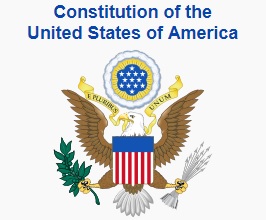 Some American citizens are armed to the teeth, and they have no intention of infringing their constitutional right to keep and bear arms. Not all Americans, by any means, but foreigners wonder why these few fanatics have this fascination with firearms. It’s like a love affair with their guns. To shed light on the American gun control issue, retired East Providence, Rhode Island police captain and author, Joe Broadmeadow, shares his thoughts and gives a brief history of America’s obsessive gun culture.
Some American citizens are armed to the teeth, and they have no intention of infringing their constitutional right to keep and bear arms. Not all Americans, by any means, but foreigners wonder why these few fanatics have this fascination with firearms. It’s like a love affair with their guns. To shed light on the American gun control issue, retired East Providence, Rhode Island police captain and author, Joe Broadmeadow, shares his thoughts and gives a brief history of America’s obsessive gun culture.
America’s Love Affair with Guns — A Brief History by Joe Broadmeadow
We can trace the genesis of the “American” gun culture back to the western expansion of the original colonies after the Revolutionary War. In crafting the Constitution, fear of a strong government backed by a standing army under the control of a monarch guided much of the design behind the American Government. Each of the three branches, Executive, Judicial and Legislative sharing power, is a check and balance against absolute centralized power.
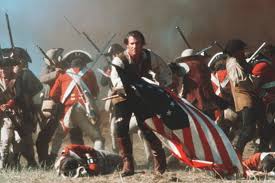 One of the most influential groups, the Scots/Irish, contributed much of the fighting force of the Continental Army and carried with them a long-imbued loathing of English royal tyranny. These backwoodsmen’s guerilla tactics served as an equalizer to the overwhelming British numbers. So successful were the tactics that Ho Chi Minh studied and adapted them in the American War in Vietnam.
One of the most influential groups, the Scots/Irish, contributed much of the fighting force of the Continental Army and carried with them a long-imbued loathing of English royal tyranny. These backwoodsmen’s guerilla tactics served as an equalizer to the overwhelming British numbers. So successful were the tactics that Ho Chi Minh studied and adapted them in the American War in Vietnam.
These Scots/Irish hated the English, hated government intrusion, and would die rather than yield. These rugged, independent colonists led the way west. Their resistance to governmental authority manifested itself in the language of the Constitution, an accommodation to these sentiments by the Virginia and New England aristocracy crafting the document.
A Well Regulated Militia
The famous Second Amendment—with its confusing wording—sought to lessen this fear when those forming the new government never envisioned the need for a standing army. They believed the separation of the Americas from Europe by the Atlantic Ocean served as deterrent enough. However, should the need arise, the states’ militias could be called to defend the country. Otherwise, they saw no harm in leaving military organization—the militia—to the control of the states.
The rifle, the primary weapon of defense and hunting, served as the instrument of the westward expansion. Pioneers used their firepower to provision their larder, and to attack and destroy the Native American populations who resisted this intrusion onto their traditional land. The image of the brave pioneer—bearing a musket rifle, powder horn and lead ball—became a fundamental part of the American psyche.
As the technology of weaponry improved, the killing became more efficient. Euro-Americans hunted the bison and Native Americans to near extinction.
Unlike other nations which grew through similar expansion—Canada, Australia, Japan, etc.—the American gun culture never outgrew its necessity or purpose in the United States. It continued into the modern world of 20th and 21st century America.
The Wild West Disappeared — The Spirit of the Wild West Never Did.
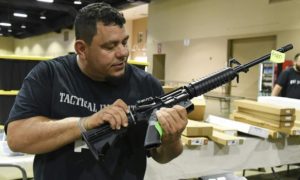 Weapon technology—driven by the Civil War and the growing American hegemony in the World Wars of the 20th century—kept improving. Improvement in firing rates and killing ability grew exponentially. In our intervention in Vietnam, we were the world power imposing our will on a peasantry through superior weaponry and overwhelming firepower. The M-16 rifle, developed and deployed during the Vietnam War, gave rise to its civilian cousin—the AR-15—the weapon of choice used in so many of the mass shootings.
Weapon technology—driven by the Civil War and the growing American hegemony in the World Wars of the 20th century—kept improving. Improvement in firing rates and killing ability grew exponentially. In our intervention in Vietnam, we were the world power imposing our will on a peasantry through superior weaponry and overwhelming firepower. The M-16 rifle, developed and deployed during the Vietnam War, gave rise to its civilian cousin—the AR-15—the weapon of choice used in so many of the mass shootings.
The Wild West disappeared, but the spirit of the Wild West never did. The American gun culture clung to these new weapons with the same enthusiasm as if still facing Indian raiding parties or starvation from failed hunting expeditions. Our unique fascination—almost to the point of irrationality—with possessing firearms prevails to this day, despite the dubious claims of necessity.
The United States Constitution’s Second Amendment
The language of the Second Amendment lends itself to a broad spectrum of interpretation. A strict absolutism mentality says the government can impose no restrictions on private ownership of firearms. But, a more literal reading interprets the second amendment to mean that firearms can be kept solely to support a “well-regulated” militia.
The courts have given little guidance which settles the matter consistently. Instead, it is a dog’s breakfast of conflicting and convoluted decisions and language. While the court upholds the government ban on private ownership of automatic weapons, sound suppressors or short-barreled shotguns, there are exceptions. The court often declines cases that offer the opportunity for more specific findings.
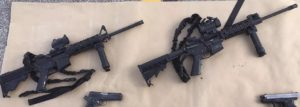 Much of the case law makes no distinction between a small caliber handgun with limited round capacity and slow reloading speed to a semi-automatic, high capacity, rapid firing, shoulder weapon with hyper-velocity rounds specifically designed to cause maximum damage to humans.
Much of the case law makes no distinction between a small caliber handgun with limited round capacity and slow reloading speed to a semi-automatic, high capacity, rapid firing, shoulder weapon with hyper-velocity rounds specifically designed to cause maximum damage to humans.
In US Supreme Court, District of Columbia v. Heller, the court struck down a District of Columbia statute restricting handgun possession citing 2nd Amendment violations. The case did not garner a unanimous vote.
Justice Breyer (a Republican appointee) joined by Justices Stevens, Souter and Ginsburg, wrote a dissent which spells out the conditions under which government might place constitutional restrictions on possession of firearms. Breyer’s dissent said the Second Amendment protects “militia” related matters, and that the realities of the 18th century made it necessary for civilians to keep firearms within their households.
Interpreting the U.S. Supreme Court Heller Decision
This interpretation does not prohibit the potential for using these weapons for self-defense purposes, but the amendment permitted this as it related to the protected militia functionality. There has not been a case with sufficient similarity granted certiorari before the court since, so the matter remains clouded even as the decision stands.
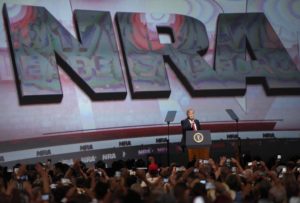 The argument most often raised by gun proponents is the protection of the people from the tyranny of government. This fails in several legal ways and one practical one. First, the separation of powers places controls over the power of the President to use military force without Congressional authority. The Posse Comitatus Act expressly prohibits the use of the military for civilian law enforcement except in times of rebellion.
The argument most often raised by gun proponents is the protection of the people from the tyranny of government. This fails in several legal ways and one practical one. First, the separation of powers places controls over the power of the President to use military force without Congressional authority. The Posse Comitatus Act expressly prohibits the use of the military for civilian law enforcement except in times of rebellion.
To circumvent these restrictions, the three co-equal elements of government would need to cooperate in an unprecedented manner. That’s highly unlikely to happen. And that’s why America can’t effectively control guns.
From a purely practical perspective, 18th and 19th century Americans had comparable weapons to those in use by the military. That changed in the 20th century. The reality is, regardless of the number of armed civilians, the chances of withstanding a direct, sustained attack by the US military is nil. The once dreaded “standing army” is not only standing, it is the most powerful military force in history. The Second Amendment was never intended to withstand a “standing” army with tactical nuclear weapons.
Guns in Private Hands for the Purpose of Personal and Public Protection
School shootings—or any mass casualty incident involving firearms—draw the most attention, but they constitute a small percentage of the death toll from guns. Suicides, criminal homicides and accidental shootings account for the overwhelming percentage of firearm-related deaths.
Often, opponents of gun control segregate these numbers, discounting suicides and accidental shootings as not germane to the discussion. They portray criminal homicides as solely attributable to those with a criminal record. It is simplistic and distorts the problem.
Another argument is to point to the murder rate in cities like Chicago with stringent gun laws and strong restrictions on issuing concealed carry permits. Again, this is a disingenuous argument. Chicago is a short drive to Indiana where gun laws are much less restrictive. A report by the FBI and the Chicago Police Department show most guns used in Chicago come from outside the city.
The problem lies in the complexity of the solution. One side sees eliminating all guns as a solution. The other sees more weapons in the hands of civilians as the solution.
Both are Wrong
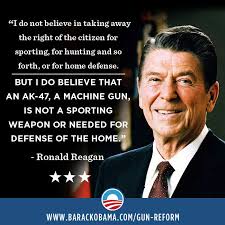 The fundamental problem in crafting a practical solution is we have no in-depth, well-designed, peer-reviewed studies of the health risk of weapons. We have only anecdotal evidence—skewed by supporters and opponents—on the effectiveness of firearms as a means of self-protection. We have no clinical study of the related health risk of gun ownership. We have no data on the track of weapons in private commerce.
The fundamental problem in crafting a practical solution is we have no in-depth, well-designed, peer-reviewed studies of the health risk of weapons. We have only anecdotal evidence—skewed by supporters and opponents—on the effectiveness of firearms as a means of self-protection. We have no clinical study of the related health risk of gun ownership. We have no data on the track of weapons in private commerce.
We need to evaluate the effect of single-parent—usually absent father—households on increasing risk factors for anti-social behavior in a clinical and reasoned manner. The commonality of a problematic childhood shared by school shooters is striking. It clamors for intense study.
We need to face the fact of our revolving door prison system, and the abrogation of government responsibility through the increasing use of private prisons. The self-fulfilling prophecy of prisons creating better criminals to keep the prisons full is a natural result of such a for-profit corrections system. Like sowing seeds for future crops, prison without rehabilitation is doomed to failing its primary purpose.
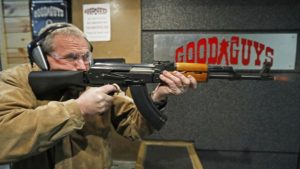 Efforts to prevent future Columbine, Sandy Hook, Parkland and Santa Fe incidents are hampered because we are blind, deaf and dumb. Our laws prevent the CDC, the ATF or the FBI from doing any meaningful tracking of firearms or their overall effect on security and health.
Efforts to prevent future Columbine, Sandy Hook, Parkland and Santa Fe incidents are hampered because we are blind, deaf and dumb. Our laws prevent the CDC, the ATF or the FBI from doing any meaningful tracking of firearms or their overall effect on security and health.
Therein Lays the First Step
To effectively control guns in America, we must remove the restrictions on studying the issue so we can formulate solutions based on facts and information rather than raw emotion. Until we have the facts about the efficacy of guns as an option for personal protection—or the net risk to the public from such policies—we cannot formulate rational solutions. Absent a concerted effort to study the problem dispassionately, we can never arrive at an effective, constitutionally-sound solution.
Until that happens, we are doomed to repeat history.
* * *
Thanks to retired East Providence, Rhode Island police captain and author, Joe Broadmeadow, for this rational, insightful and informative view of why America can’t effectively control guns.
 Joe Broadmeadow retired with the rank of Captain from the East Providence, Rhode Island Police Department after twenty years. Assigned to various divisions within the department including Commander of Investigative Services, he also worked in the Organized Crime Drug Enforcement Task
Joe Broadmeadow retired with the rank of Captain from the East Providence, Rhode Island Police Department after twenty years. Assigned to various divisions within the department including Commander of Investigative Services, he also worked in the Organized Crime Drug Enforcement Task  Force and on special assignment to the FBI Drug Task Force.
Force and on special assignment to the FBI Drug Task Force.
Collision Course and Silenced Justice, Joe’s first two novels, are from the highly-acclaimed Josh Williams series. Joe’s third mystery thriller, A Change of Hate, features one of the most popular characters from the first novels, Harrison “Hawk” Bennett, former special forces Green Beret and legendary criminal defense lawyer in a taut legal drama. The books continue to garner rave reviews, and are available on Amazon and Barnes & Noble in print, Kindle, and audio format.
Besides crime novels, Joe is developing a YA Fiction series. The first, Saving the Last Dragon, is available in Kindle, print, and audio versions. The next book, Raising the Last Dragon, is in development.
 Joe also writes for two blogs, The Writing of Joe Broadmeadow (www.joebroadmeadowblog.com) and The Heretic and the Holy Man (www.thehereticandtheholyman.wordpress.com)
Joe also writes for two blogs, The Writing of Joe Broadmeadow (www.joebroadmeadowblog.com) and The Heretic and the Holy Man (www.thehereticandtheholyman.wordpress.com)
When Joe is not writing, he is hiking or fishing (and thinking about writing). Joe completed a 2,185-mile thru-hike of the Appalachian Trail in September 2014. After completing the trail, Joe published a short story, Spirit of the Trail, available on Amazon.com in Kindle format.
Joe Broadmeadow lives in Lincoln, RI with his wife Susan. You can connect with Joe at:

